电气工程及其自动化专业英语第一章课文翻译
电气工程及自动化专业英语考试翻译课文Electric Power Systems 电力系统3.1
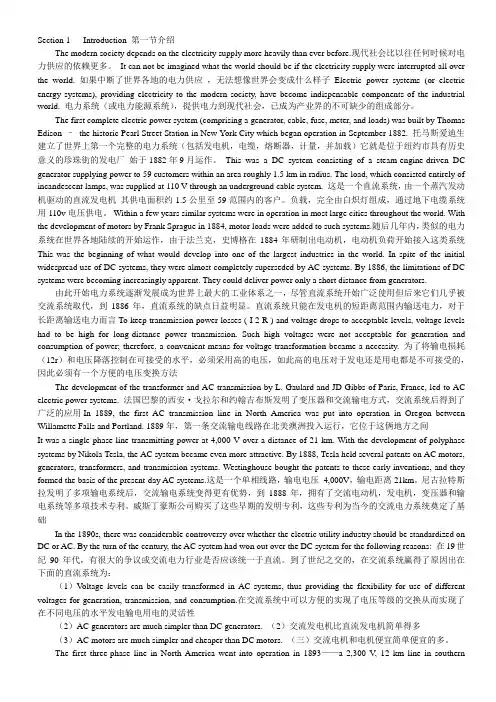
Section 1 Introduction 第一节介绍The modern society depends on the electricity supply more heavily than ever before.现代社会比以往任何时候对电力供应的依赖更多。
It can not be imagined what the world should be if the electricity supply were interrupted all over the world. 如果中断了世界各地的电力供应,无法想像世界会变成什么样子Electric power systems (or electric energy systems), providing electricity to the modern society, have become indispensable components of the industrial world. 电力系统(或电力能源系统),提供电力到现代社会,已成为产业界的不可缺少的组成部分。
The first complete electric power system (comprising a generator, cable, fuse, meter, and loads) was built by Thomas Edison –the historic Pearl Street Station in New York City which began operation in September 1882. 托马斯爱迪生建立了世界上第一个完整的电力系统(包括发电机,电缆,熔断器,计量,并加载)它就是位于纽约市具有历史意义的珍珠街的发电厂始于1882年9月运作。
This was a DC system consisting of a steam-engine-driven DC generator supplying power to 59 customers within an area roughly 1.5 km in radius. The load, which consisted entirely of incandescent lamps, was supplied at 110 V through an underground cable system. 这是一个直流系统,由一个蒸汽发动机驱动的直流发电机其供电面积约1.5公里至59范围内的客户。
(完整版)电气工程与自动化专业英语中文翻译
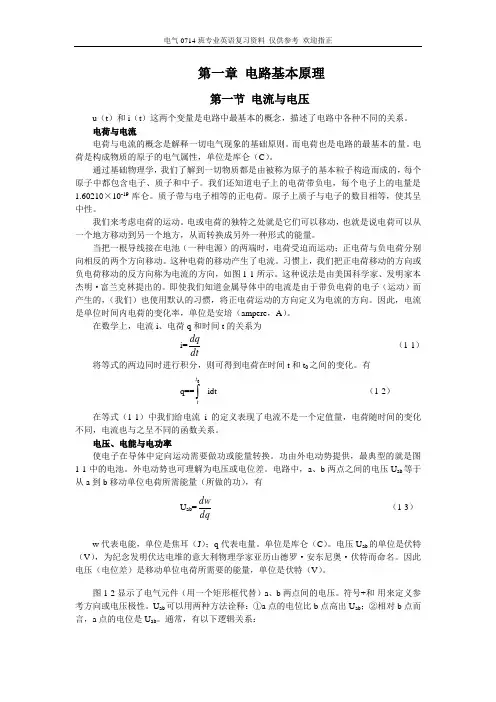
第一章 电路基本原理第一节 电流与电压u (t )和i (t )这两个变量是电路中最基本的概念,描述了电路中各种不同的关系。
电荷与电流电荷与电流的概念是解释一切电气现象的基础原则。
而电荷也是电路的最基本的量。
电荷是构成物质的原子的电气属性,单位是库仑(C )。
通过基础物理学,我们了解到一切物质都是由被称为原子的基本粒子构造而成的,每个原子中都包含电子、质子和中子。
我们还知道电子上的电荷带负电,每个电子上的电量是1.60210×10-19库仑。
质子带与电子相等的正电荷。
原子上质子与电子的数目相等,使其呈中性。
我们来考虑电荷的运动。
电或电荷的独特之处就是它们可以移动,也就是说电荷可以从一个地方移动到另一个地方,从而转换成另外一种形式的能量。
当把一根导线接在电池(一种电源)的两端时,电荷受迫而运动;正电荷与负电荷分别向相反的两个方向移动。
这种电荷的移动产生了电流。
习惯上,我们把正电荷移动的方向或负电荷移动的反方向称为电流的方向,如图1-1所示。
这种说法是由美国科学家、发明家本杰明·富兰克林提出的。
即使我们知道金属导体中的电流是由于带负电荷的电子(运动)而产生的,(我们)也使用默认的习惯,将正电荷运动的方向定义为电流的方向。
因此,电流是单位时间内电荷的变化率,单位是安培(ampere ,A )。
在数学上,电流i 、电荷q 和时间t 的关系为i=dtdq (1-1) 将等式的两边同时进行积分,则可得到电荷在时间t 和t 0之间的变化。
有q== 0t t idt (1-2)在等式(1-1)中我们给电流i 的定义表现了电流不是一个定值量,电荷随时间的变化不同,电流也与之呈不同的函数关系。
电压、电能与电功率使电子在导体中定向运动需要做功或能量转换。
功由外电动势提供,最典型的就是图1-1中的电池。
外电动势也可理解为电压或电位差。
电路中,a 、b 两点之间的电压U ab 等于从a 到b 移动单位电荷所需能量(所做的功),有U ab =dqdw (1-3) w 代表电能,单位是焦耳(J );q 代表电量。
电气工程与自动化专业英语第一章课文翻译
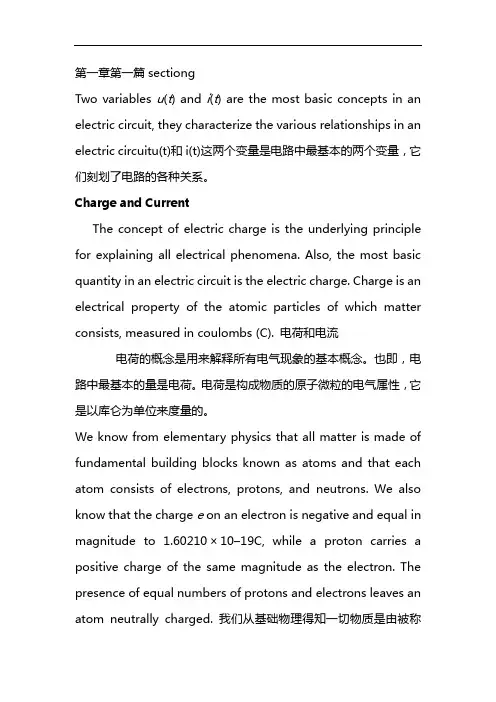
第一章第一篇sectiongTwo variables u(t) and i(t) are the most basic concepts in an electric circuit, they characterize the various relationships in an electric circuitu(t)和i(t)这两个变量是电路中最基本的两个变量,它们刻划了电路的各种关系。
Charge and CurrentThe concept of electric charge is the underlying principle for explaining all electrical phenomena. Also, the most basic quantity in an electric circuit is the electric charge. Charge is an electrical property of the atomic particles of which matter consists, measured in coulombs (C). 电荷和电流电荷的概念是用来解释所有电气现象的基本概念。
也即,电路中最基本的量是电荷。
电荷是构成物质的原子微粒的电气属性,它是以库仑为单位来度量的。
We know from elementary physics that all matter is made of fundamental building blocks known as atoms and that each atom consists of electrons, protons, and neutrons. We also know that the charge e on an electron is negative and equal in magnitude to 1.60210×10 19C, while a proton carries a positive charge of the same magnitude as the electron. The presence of equal numbers of protons and electrons leaves an atom neutrally charged. 我们从基础物理得知一切物质是由被称为原子的基本构造部分组成的,并且每个原子是由电子,质子和中子组成的。
专业英语翻译第一章
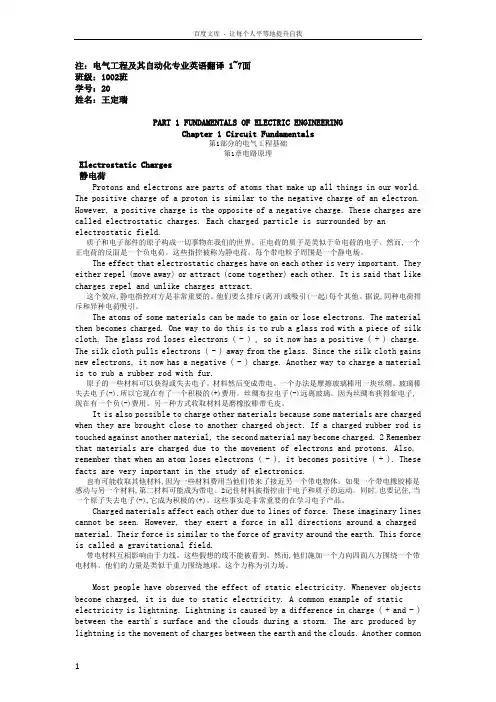
注:电气工程及其自动化专业英语翻译 1~7面班级:1002班学号:20姓名:王定瑞PART 1 FUNDAMENTALS OF ELECTRIC ENGINEERINGChapter 1 Circuit Fundamentals第1部分的电气工程基础第1章电路原理Electrostatic Charges静电荷Protons and electrons are parts of atoms that make up all things in our world. The positive charge of a proton is similar to the negative charge of an electron. However, a positive charge is the opposite of a negative charge. These charges are called electrostatic charges. Each charged particle is surrounded by an electrostatic field.质子和电子部件的原子构成一切事物在我们的世界。
正电荷的质子是类似于负电荷的电子。
然而,一个正电荷的反面是一个负电荷。
这些指控被称为静电荷。
每个带电粒子周围是一个静电场。
The effect that electrostatic charges have on each other is very important. They either repel (move away) or attract (come together) each other. It is said that like charges repel and unlike charges attract.这个效应,静电指控对方是非常重要的。
他们要么排斥(离开)或吸引(一起)每个其他。
中国矿业大学电气工程及自动化专业英语第六版 考试章节第一。二篇课文翻译

Section 1 Introduction 第一节介绍The modern society depends on the electricity supply more heavily than ever before.现代社会比以往任何时候对电力供应的依赖更多。
It can not be imagined what the world should be if the electricity supply were interrupted all over the world. 如果中断了世界各地的电力供应,无法想像世界会变成什么样子Electric power systems (or electric energy systems), providing electricity to the modern society, have become indispensable components of the industrial world. 电力系统(或电力能源系统),提供电力到现代社会,已成为产业界的不可缺少的组成部分。
The first complete electric power system (comprising a generator, cable, fuse, meter, and loads) was built by Thomas Edison –the historic Pearl Street Station in New York City which began operation in September 1882. 托马斯爱迪生建立了世界上第一个完整的电力系统(包括发电机,电缆,熔断器,计量,并加载)它就是位于纽约市具有历史意义的珍珠街的发电厂始于1882年9月运作。
This was a DC system consisting of a steam-engine-driven DC generator supplying power to 59 customers within an area roughly 1.5 km in radius. The load, which consisted entirely of incandescent lamps, was supplied at 110 V through an underground cable system. 这是一个直流系统,由一个蒸汽发动机驱动的直流发电机其供电面积约1.5公里至59范围内的客户。
电气工程及其自动化专业英语翻译
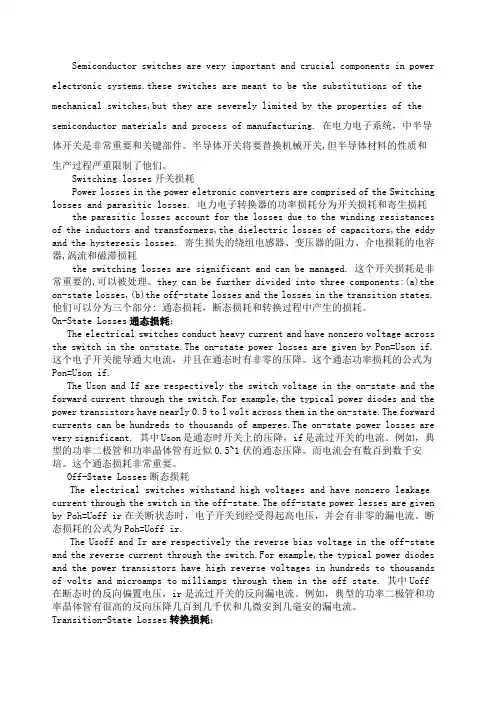
Semiconductor switches are very important and crucial components in power electronic systems.these switches are meant to be the substitutions of the mechanical switches,but they are severely limited by the properties of the semiconductor materials and process of manufacturing. 在电力电子系统,中半导体开关是非常重要和关键部件。
半导体开关将要替换机械开关,但半导体材料的性质和生产过程严重限制了他们。
Switching losses开关损耗Power losses in the power eletronic converters are comprised of the Switching losses and parasitic losses. 电力电子转换器的功率损耗分为开关损耗和寄生损耗the parasitic losses account for the losses due to the winding resistances of the inductors and transformers,the dielectric losses of capacitors,the eddy and the hysteresis losses. 寄生损失的绕组电感器、变压器的阻力、介电损耗的电容器,涡流和磁滞损耗the switching losses are significant and can be managed. 这个开关损耗是非常重要的,可以被处理。
they can be further divided into three components:(a)the on-state losses,(b)the off-state losses and the losses in the transition states. 他们可以分为三个部分: 通态损耗,断态损耗和转换过程中产生的损耗。
电气工程及其自动化专业英语翻译(精选多篇)
电气工程及其自动化专业英语翻译(精选多篇)第一篇:电气工程及其自动化专业英语翻译Electric Power Systems.The modern society depends on the electricity supply more heavily than ever before.It can not be imagined what the world should be if the electricity supply were interrupted all over the world.Electric power systems(or electric energy systems), providing electricity to the modern society, have become indispensable components of the industrial world.The first complete electric power system(comprising a generator, cable, fuse, meter, and loads)was built by Thomas Edison – the historic Pearl Street Station in New York City which began operation in September 1882.This was a DC system consisting of a steam-engine-driven DC generator supplying power to 59 customers within an area roughly 1.5 km in radius.The load, which consisted entirely of incandescent lamps, was supplied at 110 V through an underground cable system..Within a few years similar systems were in operation in most large cities throughout the world.With the development of motors by Frank Sprague in 1884, motor loads were added to such systems.This was the beginning of what would develop into one of the largest industries in the world.In spite of the initial widespread use of DC systems, they were almost completely superseded by AC systems.By 1886, the limitations of DC systems were becoming increasingly apparent.They could deliver power only a short distance from generators.To keep transmission power losses(I 2 R)and voltage drops to acceptable levels, voltage levels had to be high for long-distance power transmission.Such high voltages were not acceptable for generation and consumption of power;therefore, a convenient means for voltage transformationbecame a necessity.The development of the transformer and AC transmission by L.Gaulard and JD Gibbs of Paris, France, led to AC electric power systems.In 1889, the first AC transmission line in North America was put into operation in Oregon between Willamette Falls and Portland.It was a single-phase line transmitting power at 4,000 V over a distance of 21 km.With the development of polyphase systems by Nikola Tesla, the AC system became even more attractive.By 1888, Tesla held several patents on AC motors, generators, transformers, and transmission systems.Westinghouse bought the patents to these early inventions, and they formed the basis of the present-day AC systems.In the 1890s, there was considerable controversy over whether the electric utility industry should be standardized on DC or AC.By the turn of the century, the AC system had won out over the DC system for the following reasons:(1)Voltage levels can be easily transformed in AC systems, thusproviding the flexibility for use of different voltages for generation, transmission, and consumption.(2)AC generators are much simpler than DC generators.(3)AC motors are much simpler and cheaper than DC motors.The first three-phase line in North America went into operation in 1893——a 2,300 V, 12 km line in southern California.In the early period of AC power transmission, frequency was not standardized.This poses a problem for interconnection.Eventually 60 Hz was adopted as standard in North America, although 50 Hz was used in many other countries.The increasing need for transmitting large amounts of power over longer distance created an incentive to use progressively high voltage levels.To avoid the proliferation of anunlimited number of voltages, the industry has standardized voltage levels.In USA, the standards are 115, 138, 161, and 230 kV for the high voltage(HV)class, and 345, 500 and 765 kV for the extra-high voltage(EHV)class.In China, the voltage levels in use are 10, 35, 110 for HV class, and 220, 330(only in Northwest China)and500 kVforEHVclass.Thefirst750kVtransmission line will be built in the near future in Northwest China.With the development of the AC/DC converting equipment, high voltage DC(HVDC)transmission systems have become more attractive and economical in special situations.The HVDC transmission can be used for transmission of large blocks of power over long distance, and providing an asynchronous link between systems where AC interconnection would be impractical because of system stability consideration or because nominal frequencies of the systems are different.The basic requirement to a power system is to provide an uninterrupted energy supply to customers with acceptable voltages and frequency.Because electricity can not be massively stored under a simple and economic way, the production and consumption of electricity must be done simultaneously.A fault or misoperation in any stages of a power system may possibly result in interruption of electricity supply to the customers.Therefore, a normal continuous operation of the power system to provide a reliable power supply to the customers is of paramount importance.Power system stability may be broadly defined as the property of a power system that enables it to remain in a state of operating equilibrium under normal operating conditions and to regain an acceptable state of equilibrium after being subjected to a disturbance..Instability in a power system may be manifested in many different ways depending on the system configurationand operating mode.Traditionally, the stability problem has been one of maintaining synchronous operation.Since power systems rely on synchronous machines for generation of electrical power, a necessary condition for satisfactory system operation is that all synchronous machines remain in synchronism or, colloquially “in step”.This asp ect of stability is influenced by the dynamics of generator rotor angles and power-angle relationships, and then referred to “ rotor angle stability ”译文:电力系统现代社会比以往任何时候更多地依赖于电力供应。
电气工程及其自动化专业英语翻译
Electric Power Systems.The modern society depends on the electricity supply more heavily than ever before. It can not be imagined what the world should be if the electricity supply were interrupted all over the world. Electric power systems (or electric energy systems), providing electricity to the modern society, have become indispensable components of the industrial world. The first complete electric power system (comprising a generator, cable, fuse, meter, and loads) was built by Thomas Edison – the historic Pearl Street Station in New York City which began operation in September 1882. This was a DC system consisting of a steam-engine-driven DC generator supplying power to 59 customers within an area roughly 1.5 km in radius. The load, which consisted entirely of incandescent lamps, was supplied at 110 V through an underground cable system.. Within a few years similar systems were in operation in most large cities throughout the world. With the development of motors by Frank Sprague in 1884, motor loads were added to such systems. This was the beginning of what would develop into one of the largest industries in the world. In spite of the initial widespread use of DC systems, they were almost completely superseded by AC systems. By 1886, the limitations of DC systems were becoming increasingly apparent. They could deliver power only a short distance from generators.To keep transmission power losses ( I 2 R ) and voltage drops to acceptable levels, voltage levels had to be high for long-distance power transmission. Such high voltages were not acceptable for generation and consumption of power; therefore, a convenient means for voltage transformation became a necessity.The development of the transformer and AC transmission by L. Gaulard and JD Gibbs of Paris, France, led to AC electric power systems. In 1889, the first AC transmission line in North America was put into operation in Oregon between Willamette Falls and Portland. It was a single-phase line transmitting power at 4,000 V over a distance of 21 km. With the development of polyphase systems by Nikola Tesla, the AC system became even more attractive. By 1888, Tesla held several patents on AC motors, generators, transformers, and transmission systems. Westinghouse bought the patents to these early inventions, and they formed the basis of the present-day AC systems. In the 1890s, there was considerable controversy over whether the electric utility industry should be standardized on DC or AC. By the turn of the century, the AC system had won out over the DC system for the following reasons:(1)Voltage levels can be easily transformed in AC systems, thus providing the flexibility for use of different voltages for generation, transmission, and consumption.(2)AC generators are much simpler than DC generators.(3)AC motors are much simpler and cheaper than DC motors.The first three-phase line in North America went into operation in 1893——a 2,300 V, 12 km line in southern California. In the early period of AC power transmission, frequency was not standardized. This poses a problem for interconnection. Eventually 60 Hz was adopted as standard in North America, although 50 Hz was used in many other countries. The increasing need for transmitting large amounts of power over longer distance created an incentive to use progressively high voltage levels. To avoid the proliferation of an unlimited number of voltages, the industry has standardized voltage levels. In USA, the standards are 115, 138, 161, and 230 kV for the high voltage (HV) class, and 345, 500 and 765 kV for the extra-high voltage (EHV) class. In China, the voltage levels in use are 10, 35, 110 for HV class, and 220, 330 (only in Northwest China) and 500 kV for EHV class . The first 750 kVtransmission line will be built in the near future in Northwest China. With the development of the AC/DC converting equipment, high voltage DC (HVDC) transmission systems have become more attractive and economical in special situations. The HVDC transmission can be used for transmission of large blocks of power over long distance, and providing an asynchronous link between systems where AC interconnection would be impractical because of system stability consideration or because nominal frequencies of the systems are different. The basic requirement to a power system is to provide an uninterrupted energy supply to customers with acceptable voltages and frequency. Because electricity can not be massively stored under a simple and economic way, the production and consumption of electricity must be done simultaneously. A fault or misoperation in any stages of a power system may possibly result in interruption of electricity supply to the customers. Therefore, a normal continuous operation of the power system to provide a reliable power supply to the customers is of paramount importance. Power system stability may be broadly defined as the property of a power system that enables it to remain in a state of operating equilibrium under normal operating conditions and to regain an acceptable state of equilibrium after being subjected to a disturbance.. Instability in a power system may be manifested in many different ways depending on the system configuration and operating mode. Traditionally, the stability problem has been one of maintaining synchronous operation. Since power systems rely on synchronous machines for generation of electrical power, a necessary condition for satisfactory system operation is that all synchronous machines remain in synchronism or, colloquially "in step". This aspect of stability is influenced by the dynamics of generator rotor angles and power-angle relationships, and then referred to " rotor angle stability "。
电气工程及其自动化英语英译汉
1```In the generator mode ,it,s operating speed isslightly higger than it,s synchronous speed and ie needs magnetizing revctive pover form the symtem that it is connected to in order to suuply pover .在发电方式下他的工作速度比同步转速稍高些,并了解供电力,他需要他所连接的系统吸收磁化无功功率。
2```in the barking mode of operyetion ,a three –phase indection motor running at a steady –speedcan be brought to a quick stop by interchanging two of stator leads感应电机运行电动状态时,其转速低于同步转速,运行在发电状态时,其转速高于同步转速,这就需要从与之间相连的系统电源提供励磁的无功功率。
3```obviously ,dc machine applications are very significant,but the advantages of the dc machinemmust be weighed against its greatr initial investment cost and the maintenance problems associated with its brush-commutator system..同步是指状态运行时点击以恒定的转速和频率运行。
4```with a cylindyical rotor the reluctance of the magnetic circuit of the field is independent of itsactual diretion and relative to the direct axis.圆柱形转子的磁场磁路的磁阻与直轴有关,而与磁场的实际方向无关。
电气工程专业英语+unt1参考文档
Unit 1 Fundamentals of Electronic Circuits
1.1 Introduction to Circuit Theory 1.2 Analog and Digital Circuits 1.3 Three-Phase Circuits 1.4 Further Reading
Notice that the three points that form node b ① are connected by perfectly conducting wires and therefore constitute a single point.
Note:① "three points that form node b "表示"形成节点
b的3个点".此句可译为:注意到形成节点b的3个点是通过理
elements or devices, whereas a circuit is a network
providing one or more closed paths③.
Note:②:regard … as表示“把…认为” NNoottee::③①::pdrioffveirtfherse为ntiate nbeettwwoerekn的A后an置d 定B表语示。区分A和B;To differentiate between a circuit and a network是目的状语从句.
series
n. 连续;系列;级数;串联
parallel
adj. 平行的;并联的 n. 平行线;平
行面;v. 相应;平行
impedance
n. [电]阻抗;全电阻;[物]阻抗
theorem
n. [数]定理;法则
- 1、下载文档前请自行甄别文档内容的完整性,平台不提供额外的编辑、内容补充、找答案等附加服务。
- 2、"仅部分预览"的文档,不可在线预览部分如存在完整性等问题,可反馈申请退款(可完整预览的文档不适用该条件!)。
- 3、如文档侵犯您的权益,请联系客服反馈,我们会尽快为您处理(人工客服工作时间:9:00-18:30)。
第一章第一篇sectiongTwo variables u(t) and i(t) are the most basic concepts in an electric circuit, they characterize the various relationships in an electric circuitu(t)和i(t)这两个变量是电路中最基本的两个变量,它们刻划了电路的各种关系。
Charge and CurrentThe concept of electric charge is the underlying principle for explaining all electrical phenomena. Also, the most basic quantity in an electric circuit is the electric charge. Charge is an electrical property of the atomic particles of which matter consists, measured in coulombs (C). 电荷和电流电荷的概念是用来解释所有电气现象的基本概念。
也即,电路中最基本的量是电荷。
电荷是构成物质的原子微粒的电气属性,它是以库仑为单位来度量的。
We know from elementary physics that all matter is made of fundamental building blocks known as atoms and that each atom consists of electrons, protons, and neutrons. We also know that the charge e on an electron is negative and equal in magnitude to 1.60210×10-19C, while a proton carries a positive charge of the same magnitude as the electron. The presence of equal numbers of protons and electrons leaves an atom neutrally charged. 我们从基础物理得知一切物质是由被称为原子的基本构造部分组成的,并且每个原子是由电子,质子和中子组成的。
我们还知道电子的电量是负的并且在数值上等于 1.602100×10-12C,而质子所带的正电量在数值上与电子相等。
质子和电子数量相同使得原子呈现电中性。
We consider the flow of electric charges. A unique feature of electric charge or electricity is the fact that it is mobile; that is, it can be transferred from one place to another, where it can be converted to another form of energy让我们来考虑一下电荷的流动。
电荷或电的特性是其运动的特性,也就是,它可以从一个地方被移送到另一个地方,在此它可以被转换成另外一种形式的能量。
When a conducting wire is connected to a battery (a source of electromotive force), the charges are compelled to move; positive charges move in one direction while negative charges move in the opposite direction. This motion of charges creates electric current. It is conventional to take the currentflow as the movement of positive charges, that is, opposite to the flow of negative charges, as Fig.l-1 illustrates. This convention was introduced by Benjamin Franklin (l706~l790), the American scientist and inventor. Although we now know that current in metallic conductors is due to negatively charged electrons, we will follow the universally accepted conventionthat current is the net flow of positive charges. Thus, Electriccurrent is the time rate of charge, measured in amperes (A).Mathematically, the relationship among current i , charge q , andtime t is 当我们把一根导线连接到某一电池上时(一种电动势源),电荷被外力驱使移动;正电荷朝一个方向移动而负电荷朝相反的方向移动。
这种电荷的移动产生了电流。
我们可以很方便地把电流看作是正电荷的移动,也即,与负电荷的流动方向相反,如图1-1所示。
这一惯例是由美国科学家和发明家本杰明-富兰克林引入的。
虽然我们现在知道金属导体中的电流是由负电荷引起的,但我们将遵循通用的惯例,即把电流看作是正电荷的单纯的流动。
于是电流就是电荷的时率,它是以安培为单位来度量的。
从数学上来说,电流i 、电荷q以及时间t 之间的关系是:The charge transferred between time t 0 and t is obtainedby integrating both sides of Eq. (1-1). We obtain 从时间t0到时间t 所移送的电荷可由方程(1-1)两边积分求得。
我们算得:The way we define current as i in Eq. (1-l) suggests that currentneed not be a constant-valued function, charge can vary withtime in several ways that may be represented by different kindsof mathematical functions 我们通过方程(1-1)定义电流的方式表明电流不必是一个恒值函数,电荷可以不同的方式随时间而变化,dq i dt= (1-1)0tt q idt = (1-2)⎰这些不同的方式可用各种数学函数表达出来。
电压,能量和功率To move the electron in a conductor in a particular direction requires some work or energy transfer. This work is performed by an external electromotive force (emf), typicallyrepresented by the battery in Fig.l-1. This emf is also knownas voltage or potential difference. The voltage u ab between twopoints a and b in an electric circuit is the energy (or work) needed to move a unit charge from a to b; mathematically 在导体中朝一个特定的方向移动电荷需要一些功或者能量的传递,这个功是由外部的电动势来完成的。
图1-1所示的电池就是一个典型的例子。
这种电动势也被称为电压或电位差。
电路中a 、b 两点间的电压等于从a 到b 移动单位电荷所需的能量(或所需做的功)。
数学表达式为:where w is energy in joules (J) and q is charge in coulombs (C).The voltage u ab is measured in volts (V), named in honor of theItalian physicist Alessandro Antonio Volta (l745~l827), whoinvented the first voltaic battery. Thus, Voltage (or potentialdifference) is the energy required to move a unit charge throughan element, measured in volts (V). 式中w 是单位为焦耳的能量而q 是单位为库仑的电荷。
电压Uab 是以伏特为单位来度量的,它是为了纪念意大利物理学家Alessandro Antonio Volta 而命名的,这ab dw u dq= (1-3)位意大利物理学家发明了首个伏达电池。
于是电压(或电压差)等于将单位电荷在元件中移动所需的能量,它是以伏特为单位来度量的。
Fig.l-2 shows the voltage across an element (represented by a rectangular block ) connected to points a and b . The plus (+) and minus (-) signs are used to define reference direction or voltage polarity. The u ab can be interpreted in two ways: ①point a is at a potential of u ab volts higher than point b; ②the potential at point a with respect to point b is u ab. It follows logically that in general 图1-2显示了某个元件(用一个矩形框来表示)两端a 、b 之间的电压。
